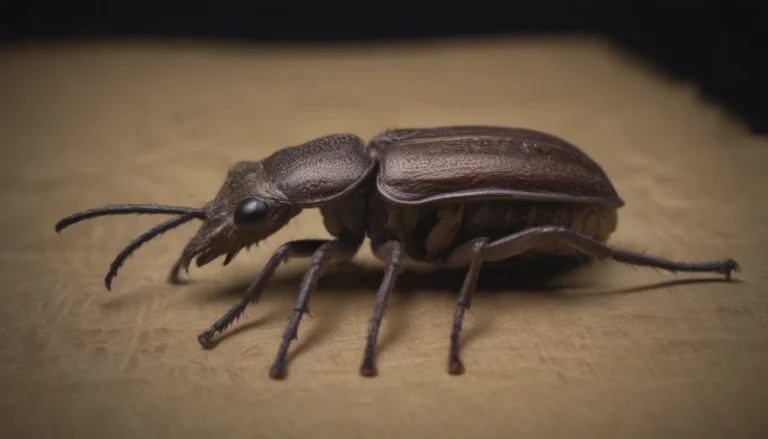Everything You Need to Know About Tarantula Hawk Wasps

Tarantula hawk wasps are fascinating creatures known for their painful stings, but don’t let their intimidating reputation scare you. In this comprehensive guide, we’ll delve into the world of these unique insects, from how to identify them to tips on getting rid of them. So grab a cup of coffee and get ready to learn all about tarantula hawk wasps in a friendly and informative style.
What Are Tarantula Hawk Wasps?
Tarantula hawk wasps belong to the genera Pepsis and Hemipepsis, and they are solitary creatures that prey on spiders like tarantulas. Unlike social wasps that live in colonies, these wasps prefer to live alone. Their name comes from their dangerous ability to paralyze tarantulas and feed them to their young. Despite their intimidating sting, tarantula hawk wasps are not aggressive towards humans and usually only sting when provoked. These creatures are most active during the hot summer months, buzzing near the ground in search of prey.
How to Identify Tarantula Hawk Wasps
Tarantula hawk wasps are unmistakable with their metallic blue-black bodies measuring around 2 inches in length. They may have wings that are similarly colored or yellow-orange with black edges. Females typically have curly antennae, while males sport straight antennae. Another distinguishing feature is their long, velvety black legs with hooked claws. If you look closely, you’ll notice distinct veining in their wings, which is a helpful characteristic for identifying them.
Signs of Tarantula Hawk Wasps Near Your Home
If you live in an area known for wild tarantulas, chances are you’ll find tarantula hawk wasps nearby as well. These creatures use tarantulas and other large spiders as hosts for their offspring. While they don’t form swarms like social wasps, you may notice them buzzing around their favorite food sources. Tarantula hawk wasps enjoy flower nectar, fruit juice, and berries, making them active during the day and most prominent in the summer. Be cautious when outdoors, as accidental stings can occur if you unknowingly disturb these insects.
How to Get Rid of Tarantula Hawk Wasps
While experts recommend leaving tarantula hawk wasps alone, there are ways to safely remove them from your property. Here are three methods you can try:
-
Destroy the Nest Using Insecticide Powder (Most Effective): Locate the wasp’s burrow during the day and apply carbaryl-based insecticide powder inside the entrance. Alternatively, pour gasoline down the burrow and cover it with a wet towel to kill the wasps. Wait a couple of days before disposing of the nest.
-
Create a DIY Trap: Make a homemade trap to catch the wasp and eliminate the problem. As these insects live alone, trapping a single wasp can solve the issue.
-
Encourage Natural Predators: If you have roadrunners or bullfrogs in your area, they can help control the tarantula hawk wasp population. Consider creating a habitat that attracts these predators to keep the wasps at bay.
How to Prevent Tarantula Hawk Wasps From Entering Your Home
To avoid encountering tarantula hawk wasps indoors, seal any cracks, crevices, and gaps in your home’s structure. Ensure that doors and windows are tightly closed and screens are in good condition. These ground-hunting wasps can easily enter homes seeking cool spaces, so it’s essential to take preventative measures. Additionally, wearing shoes outdoors can protect you from accidental stings.
Tarantula Hawk Wasp vs. Asian Giant Hornet
Confused between tarantula hawk wasps and Asian giant hornets? While both are large insects, tarantula hawk wasps have blue-black bodies and wings, whereas Asian giant hornets sport orange and black stripes. Knowing these differences can help you identify these creatures correctly.
When to Call a Professional Exterminator
In most cases, you won’t need to call a professional for a single tarantula hawk wasp sighting. However, if you suspect a larger infestation or have tarantulas entering your home, seeking assistance from a licensed pest professional is advisable. They have the expertise and tools to handle infestations effectively and identify underlying issues that may attract these creatures.
Conclusion
In conclusion, tarantula hawk wasps may have a fearsome reputation, but they play a vital role in the ecosystem. By understanding their behavior and following prevention tips, you can coexist with these intriguing insects safely. Remember, while their sting may be painful, tarantula hawk wasps are generally not aggressive towards humans. So, next time you spot one buzzing around, take a moment to appreciate their unique beauty and respect their place in the world. Stay informed, stay safe, and happy reading!
References:
– The Most Painful Wasp Sting in the World Explained. Natural History Museum.
– Biting, Stinging and Venomous Pests: Insects. University of Arizona.





